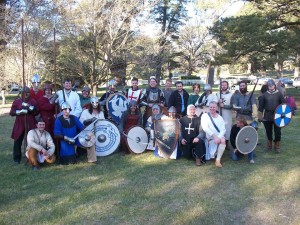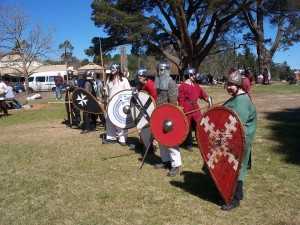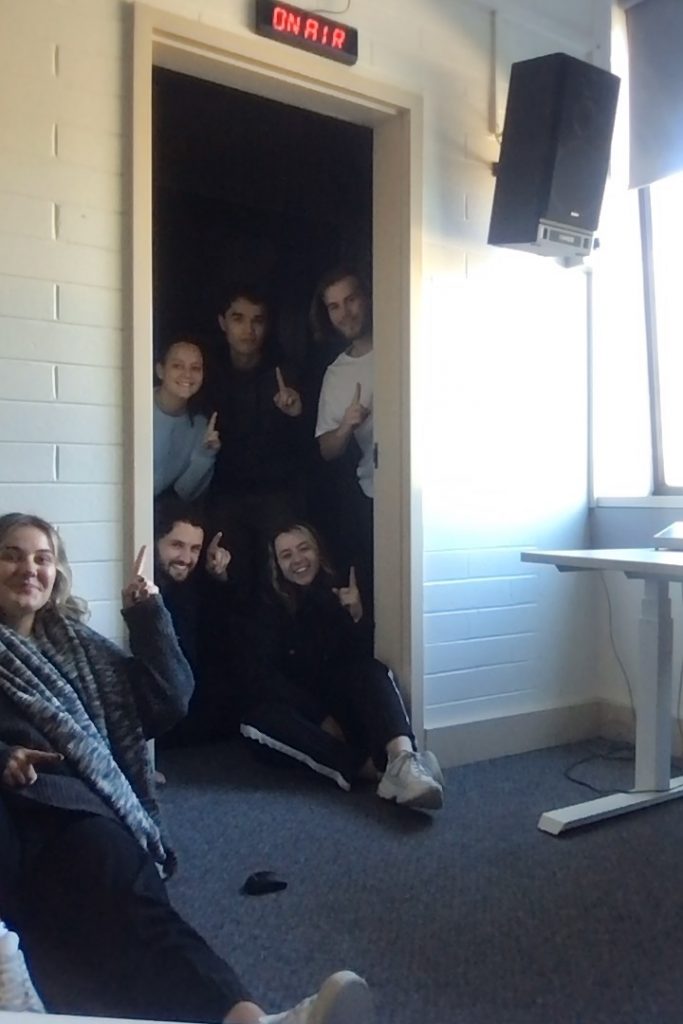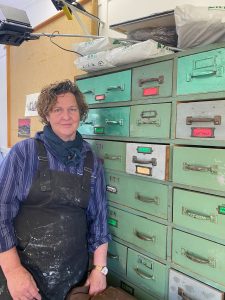Smashing Shields and Forging Steel – A Look at the Canberra Ancient Arts Fellowship

Source: AAF Facebook Page
If you have ever wanted to go back in time and experience life in the past then you may be closer to that than you realise. The Ancient Arts Fellowship, or AAF (pronounce ‘aahff’) are a Medieval re-enactment group in Canberra. I spoke to their president, Christopher Mackie, about the group.
Friedel Marquardt: What is the Ancient Arts Fellowship?
Christopher Mackie: The Ancient Arts Fellowship is a Viking re-enactment group. Basically we’re looking at the time period from Northern Europe from 796, which is the beginning of the Viking period, to 1066, which is the end of the Anglo-Saxon period in England.
Why do you re-enact this period?
It’s not very well known. It’s actually easier to do Roman re-enactment because we have their records. But, the other part is, appreciation for what we actually have. We go away and do period camping with other clubs, and then you get back to real life and you appreciate the hot water. You [really] appreciate the microwave and the ability just to throw something in the oven and have it cooked without having to plan four or five hours in advance.
The other aspect to it is the fighting. We do a mix of sports fighting and martial arts fighting. But I suppose the third aspect for a lot of people is the bling. Modern Australians tend to wear very dark or colours in very restricted ranges. We don’t often see men getting around with necklaces and really bright colours or with their hair done in very different ways. So, that also is a very attractive element of the re-enactment.
Why re-enact? What is it about re-enactment that you like?
Me personally, I’ve always liked history, always loved studying history. And this is just another form of studying history. It’s just another way of interpreting the cold book history.
Is re-enactment very big in Australia?
It is, for such an unusual past time. There are quite a number. We’ve got groups stretching from Melbourne to Townsville, and from Sydney to Perth. There is quite a number of groups. There’s actually two in Canberra. There’s the Ancient Arts Fellowship, which is a metal using group, and Society of Creative Anachronism, which is an international group. We’re not as big as they are.

Going to “Game of Thrones”, has there been any increase in popularity in the AAF with the rise of “Game of Thrones”?
Not really. We still get a steady trickle of recruits from all ages and all professions. But we got a little bit more public acceptance. Before “Game of Thrones” and “Vikings” came out [people would respond] “Oh, weird guys with swords in the park. I’ll just ring the police”. And quite often we’ll get the police to come around and they’ll go, “Oh wow, this is great. Can you show us something?”
[But] they know us. We’ve been in Canberra since 1986, so we have a very good relationship with the authorities. But the public, with those two shows, accept a little more.
We do get the occasional person go, “I’ve read a book, I play [Dungeons and Dragons], I know what I’m doing,” and then they end up going to The Hundred Swords, which is a foam fantasy group.
Is that also in Canberra?
Yup. They have fun beating each other up with foam. Because for [an AAF] fighting recruit it’s three to six months before they can actually spar.
We use steel weapons, we use steel armour and one of the most important aspects of our fighting is safety. A lot of us are public servants and a lot of us are allergic to more paperwork. So, we can’t have recruits hurting us or themselves. Some people don’t like that aspect; they want to be in the fighting on the same day.
Occasionally we get people who are sick of Hundred Swords and they come to us because they want to experience a bit more realism. And I say a bit because we are very restricted by what we can do in our fighting. In our crafting we can do everything.
What sort of restrictions do you have in your fighting?
[In the past] a lot of the tactics were designed to defeat the armour they were wearing. And the armour they were wearing [was] helmets with cheek plates or eye-rings, and maille, which is a mesh. So, basically they aim for the neck, they aim for the eyes, fingers or knees. We can’t do that; we’re a bit more restricted. And also we train to what’s called “pull the blow”.
What is that?
Basically, it’s where the sword gets thrown at full force and full speed but it impacts with minimal force, so that there’s a resounding hit on the helmet so it gives you a good noise but it doesn’t actually damage the person inside it. We don’t play to submission. We play till the first good hit, which is the first hit the person feels and goes “Oh, I’m dead now”.
And you also do public displays where you educate students. What are their responses to the re-enactment?
The students absolutely love it. The teacher, well, some don’t know what they’re getting when they purchase our services. We’ve had one instance in my time where we actually had to deploy a crafter to support the teacher because for our public displays we do what’s called a shield breaking fight. The shield is deliberately not made to shield fighting standards. It’s just 2 millimetres of wood with a boss to protect the fighter’s hand. And then we break it with a two headed axe during the fight. It’s a lot of training. [A] combined 40 years’ experience to do the fight.
Unfortunately the teacher thought we were trying to kill each other and nearly fainted on us. But the kids loved it.
How big is the AAF? How many members do you have?
About 50.
And varying ages and walks of life?
We range from house husbands to senior executive service in the public service, to professional historians. We’ve got six archaeologists, two conservators, and then anywhere in between. Our youngest member is 12. Unfortunately he’s restricted to doing craft. He really wants to fight, but he’s just not in our age. He’s throwing himself into learning how to sew, and woodwork and blacksmith and all the skills that we’ve got to offer.
So sewing is not just limited to women. Would you say it’s sort of even with the men and women that want to [take part in the AAF]?
No. We don’t have a balance in fighting. I’d like to see a balance in fighting, but it just isn’t attractive. We’ve got four female fighters that get in the middle. It can get a bit push and shove in the middle and some ladies don’t like that. Some gentlemen don’t like that either. But the fighting is more a male dominated area, unfortunately.
The crafting’s fifty-fifty, like our blacksmiths. We’ve got one female armourer, one lady blacksmith, who just does general blacksmithing, and the other blacksmith is male and they work together as a team. But the archery, traditional archery, is very much female dominated.
With the blacksmithing and forgery, how long does it take to make swords?
We don’t make swords because we don’t have the time or correct machinery. Basically, we can make everything from helmets to, they call is Saxes, they’re knives about thirty centimeters long. A properly shaped and fitted helmet can take five weekends to build. A knife, depending on the skill of the blacksmith and depending on what steel they’re [forging] from…if they’re making a simple knife it could be a matter of hours. If they’re making something much more decorative, if they are twisting wire together and getting decorative patterns through the steel of the knife that’s visible, that might take a week’s worth of work.
And what’s the process of becoming a member of AAF?
Basically, sign the form and pay the money. The fee for a student is $20 for the year and the fee for a working adult is $25. It’s just to cover our insurances. We don’t make anything from our members. The way we make money is through feasts and school displays and events.




Be the first to comment!